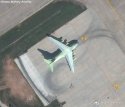Here's a fan made what-if variant of Y-20. One that could perhaps serve as a better basis for other variants of the plane. Not optimized for cargo transport but optimized for longer endurance and tanker missions.
Underlying idea is to retain as much of the plane as possible, to simplify the development. Thus the whole wing structure and pretty much all aerodynamic surfaces are unchanged. Wing root box should also be unchanged. Cockpit could probably remain unchanged.
Changes would involve: New fuselage. New interface between wing root box and the fuselage. New landing gear.
Fuselage could be made narrower. That in itself should mean less weight and less drag. But since the floor of the plane doesn't actually need to carry heavy loads, the whole fuselage structure can be made simpler and lighter. It's not only the floor itself, but the side walls, that would otherwise be part of the structure supporting those heavy loads. Only structuraly heavy parts of the fuselage would be vertical joints leading from the wingbox to the main landing gear, as well as structure connecting the forward landing gear to the backbone of the plane.
Idea would be to feature a backbone (which exists anyway in Y20 fuselage, connecting the wingbox to the tail section) alongside the upper fuselage, from which the fuel tank section would hanging off. (a good deal of fuel would also be placed inside wing structure, IF Y20 already does it that way. Which it likely does, as most planes do)
Then underneath that backbone and fuel tanks would be the cabin space. Nothing too big. But it would provide ample space for AWACS operators anyway. Or for any kind of special missions planes.
Landing gear would have longer legs and would be closer to commercial airliners. MLG nacelles would still need to protrude from the fuselage, as otherwise the MLG would not be sufficiently far apart, but could be made smaller and less draggy. Instead of going straight up as on Y20, the MLG would fold to the side, inside the nacelle and closer to the center of the fuselage. As in most commercial airliners.
Overall, such a variant could be a few tens of tons lighter. And somewhat less draggy. Overall mission endurance might be improved by non-negligible margin. Theoretically, with whole plane being lighter, one day a whole new engine might be fit, and the plane modified to one such engine per wing, instead of 2, for further improvement in effectiveness.
Some future c292 derived plane might make such effort pointless, but if that gets protracted, a narrower y20 variant might not be so crazy. Though, realistically, it might still be too costly to develop, given the number of required planes to be produced.








